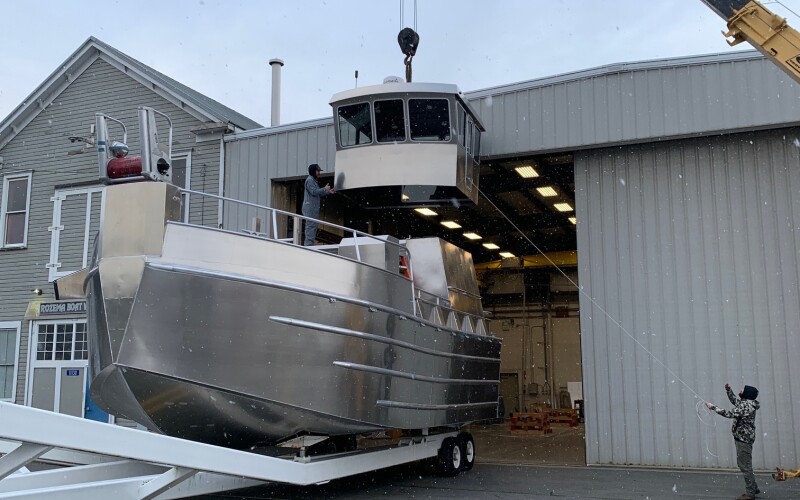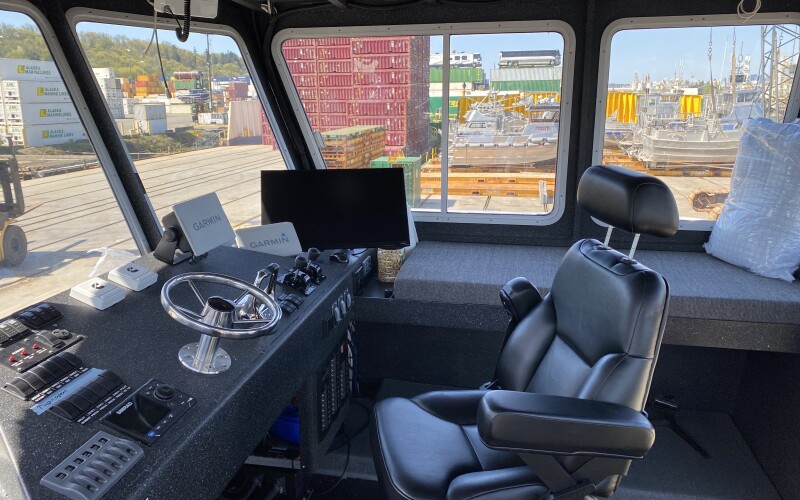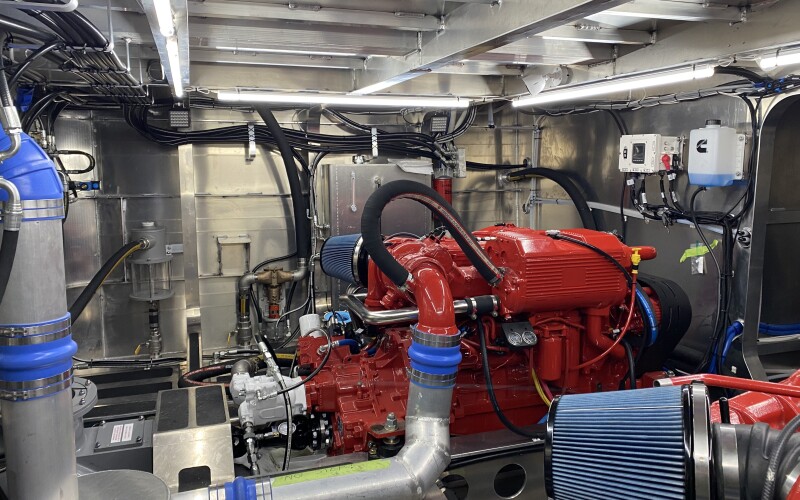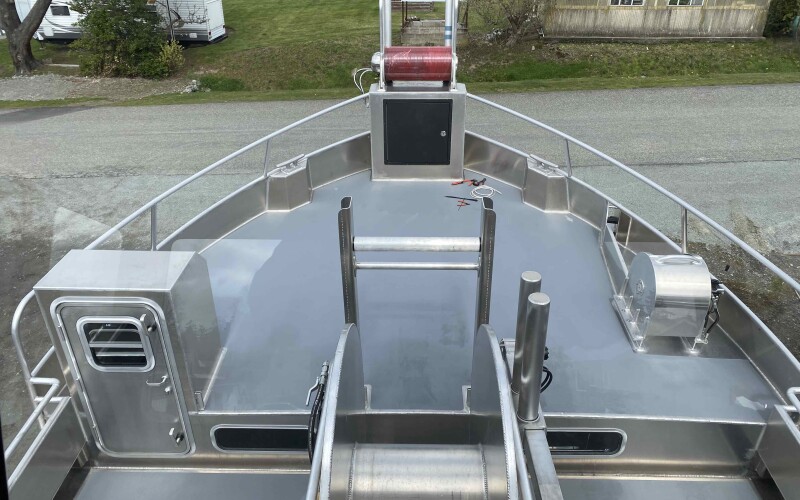Fishing in the shallow waters of Bristol Bay requires a vessel capable of navigating through even the smallest depths. Ever since his college days when he ventured to Alaska in pursuit of lucrative summer employment back in 2009, Omar Keval has dedicated himself to fishing the Bristol Bay sockeye fishery. Over the years, he's honed his skills in this particular fishery, becoming quite proficient at it. Now, in 2023, Keval finally acquired a boat that perfectly complements his expertise—the Rita K, a Rozema through-picker. With his new vessel, he embarked on his fishing endeavors in Bristol Bay, ready to confidently tackle the challenges of the shallow waters.
“I chose the Rozema boat because it has a huge deck, and you can fish super shallow with it, even with weight on,” says Keval, who credits Chad Studebaker with a design similar to Rozema’s. “Chad built the Jerry G, which is about five years older than mine,” he adds, noting that the Jerry G may have set a record in the 2023 season with a delivery of over 50,000 pounds. Keval did not match that.
And Keval’s new boat is fast.
“My old Rita K – I kept the name – went about 15 knots,” says Keval. “The new one did 39 knots in sea trials, but I mostly go around 30 when we’re empty.” When loaded and heading for a tender, Keval figures the 17-foot-wide Rita K plows along at about six knots.
“It holds 21,000 pounds below deck. The most we ever had on was 26,000, with the other 5,000 in deck bags, all bled.
Another thing I like about the boat is how they distribute the weight,” says Keval, noting that the Rita K doesn’t draw much water even when he has a lot of weight. “And empty it doesn’t sit heavy in the stern.”
But 2023 was hardly the best year to start with an expensive new boat.
“That price (for salmon) was a punch in the gut,” says Keval, but he and his four-person crew made the best of it, and they enjoyed the boat. “Having the wheelhouse in the back is nice. The waves don’t hit you as hard, and you can see what’s happening on deck.”

Even with that improved visibility, Keval has a camera system that allows him to see what is happening around the boat. “It’s just something I bought at Costco,” he says. “But it lets me see what’s going on in the engine room and down in the bow and in the tunnel under the wheelhouse, which is important for crew safety.”
Rozema Boatworks, in Mount Vernon, Wash., put a bunk and a sink in the wheelhouse for Keval. No galley, though. “The crew brings me coffee,” Keval says.
The electronics suite consists primarily of Garmin machines and a Simrad autopilot. “I have the GPSMAP 943xsv plotter with GMR 18 HD+ Radome radar. I also have the Garmin ECHOMAP UHD 74cv chartplotter/sonar and the Simrad A2004 Autopilot packs,” says Keval. “I have two transducers – the depth sounders work through the plotters.”
Keval notes that he has three displays in the wheelhouse: one for a plotter, one for a plotter and radar combination, and one backup. Communications consist of two VHF and a Garmin InReach. While Keval did not install a Starlink satcom in 2023, he plans to have it in 2024.

Below the wheelhouse, one support tower houses a shower and head, the other provides storage space for tools and spare parts, and access to the engine room. The engine room is home to the Rita K.’s two 600hp Cummins with ZF 305 gears running at 1.22:1 and a pair of MJP 340HT UltraJets.

Keval spends much of the off-season traveling, and between signing the contract for the boat in April 2022 and accepting delivery in May 2023, he only visited the project twice. “They sent me photos and updates,” says Keval. “But I mostly left them to do the work the way they wanted to,” Keval recalls, though, that he did wonder if it would be done in time to fish. “I was a little nervous, but they got it done and got it on the barge,” he says.
Another worry was the 10-ton Pac West Refrigerated Seawater (RSW) system. “There was a question about whether the transom-mounted chiller would count as part of the boat's length,” says Keval. “But that turned out okay.” Keval’s 10-ton Pac West RSW system runs off one of the 4.8 cube hydraulic pumps on the front of each engine.
“I have 8 sections in the hold, and I can isolate them electronically, two at a time, so I have four zones that I can chill independently,” says Keval. “We can take the fish down to 35 degrees. Ice forms on the condenser if we go much lower than that.”
The Rita K has a 40-gallon water tank that Keval estimates they fill from the tender every few days. “And we have a filter, so it tastes okay. The fuel tank is in the middle of the boat. It holds 400 gallons,” says Keval. “That’s part of the weight distribution I like.”
Above deck, running off the other hydraulic pump, Keval has deck gear made by Maritime Fabrication in La Conner, Wash. “I have a pretty big drum,” he says. “It can hold 200 fathoms, about 8 shackles. It has a level wind, but not the Bowser pivot. The bow and stern rollers are also Maritime Fab.”
While Maritime Fab collaborated with Marine Hydraulic Consultancy to build a freewheeling net drum, the Drifter, that will allow boats to set on step without stressing the hydraulic motor, Keval opted for a standard Maritime Fab drum. “I’m fairly conservative,” he says. “I think I set on step maybe twice. My drum is on a rotating base though, so I can spin it around to haul from the bow or stern.”

Down forward, the crew has four bunks and a small galley. “I try to give my crew the support they need to do the job,” says Keval. “I like to think we have the best food in the bay.” When it comes to finding crew, Keval is highly selective. “I am pretty diligent when looking for crew. We are a team and are only as good as the weakest link. But it works out pretty well when everyone sees that everyone else has the same goal, and we’re all doing as much as possible to catch it.”
For the winter, Keval has the Rita K in Naknek, Alaska, waiting for the Rozema crew to make a few fixes. “You know, it’s a new boat. There is always something,” he says.







